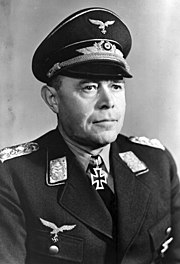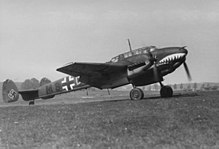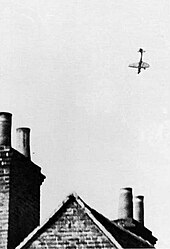The Hardest Day
[7] Until the Luftwaffe was ready to begin operations over the mainland, the first phase of the German air offensive targeted British shipping in the Channel.
[10] Still, the attacks succeeded in forcing the British to abandon the Channel convoy route and to redirect shipping to ports in north-eastern Britain.
With this achieved the Luftwaffe began the second phase of its air offensive, attacking RAF airfields and support structures in Britain.
[19] Despite the failure of Adlertag and considerable loss rates on 15, 16 and 17 August, Kesselring convinced Göring that the only sound strategy was to continue to send heavily escorted bombers to destroy British airfields.
In consultation with Hugo Sperrle, commanding Luftflotte 3 (Air Fleet 3), he chose not to scatter his effort against a large number of targets.
Up to the late spring of 1940, Fighter Command had been preparing to meet a possible air attack on the British Isles coming only from due east, from Germany itself; prior to the German victory in Western Europe.
Even if the British fighters reached the bombers without interception, the chaos of modern aerial combat made it impossible to concentrate attacks with large, rigid formations.
[34] The V or Vic formation was developed in June, which made a greater emphasis on each pilot looking for the enemy, search capability and avoiding being taken by surprise.
[37] By the summer, 1940, the Chain Home radar stations along the English and Scottish coasts were able to track incoming aircraft from continental Europe at all but the lowest altitudes.
To assess their identity, IFF (Identification Friend or Foe) could, by means of a distinctive blip on radar screens, distinguish German and British aircraft.
[49] Meanwhile, Gerhard Schöpfel, leading III./JG 26 and Bf 109s from JG 3, 40 in total, were already crossing the Dover straits to sweep the skies clear ahead of the main raid.
[49] Around 50 miles to the south-west, the nine Do 17s of 9 Staffel were at wave-top height, halfway between Dieppe, Seine-Maritime and Beachy Head, intent on sneaking under British radar beams unobserved.
They immediately telephoned a warning to Observer Group Headquarters at Horsham and fighter sector stations in the area, including RAF Kenley.
In accordance with policy, it was shut down to deny the Germans the opportunity to use it as direction-finding beacon and the BBC Home Service was taken off air in the process.
As the Germans burst over the airfield the air was suddenly filled with tracer rounds as the Dorniers' gunners engaged the Bofors and British AAA defences.
[65] Oberleutnant Rudolf Lamberty (carrying Joachim Roth) also managed to avoid a collision, but before he could do so ground fire hit his Dornier destroying the fuel tanks.
So close had the RAF fighters pressed home their attacks that the bombers had to move and jink to avoid their fire, putting the bomb-aimers off their aim.
However, the haze might enable the Germans to slip by and leave the concentrated force of RAF fighters near Canterbury striking at thin air.
[88] Hugo Sperrle, the commander of Luftflotte 3 gave orders for dive bomber units to attack radar stations and airfields on the southern coast of England.
The long trip and low speed of the Ju 87s meant there was plenty of time to catch up without burning fuel keeping close contact with the Stukas.
Early on bombs struck the field's oil tanks and storage compounds causing an enormous blaze which contributed to the crippling damage on the airfield.
As the Bf 109 escorts turned to meet the two engaging RAF Squadrons, around 300 aircraft filled a patch of sky 25 miles long, from Gosport to Bognor Regis.
The remaining units were to climb to altitude and wait over or near the threatened fighter airfields, until a clearer picture emerged of enemy intentions.
[119] Another pilot, Flight Lieutenant Dick Lee, a veteran of the Battle of France and a flying ace with nine victories, was reported missing in action.
[129] Over-claiming of aerial victories was common, and for the 18 August action, British propaganda claimed 144 German aircraft destroyed, which was over twice the true figure.
Of this total, 59 were lost to certain or probable action by fighters while two fell to ground fire, four to a combination of both and one collided with a British training aircraft.
Nos 12 and 13 Groups in the Midlands and north of Britain, with a third of the serviceable fighters between them, put up 129 (or only 15 per cent) of the day sorties, and of these only three made contact with the enemy.
Operations against Kenley, Biggin Hill, North Weald and Hornchurch had the potential to destroy 11 Group's major sector stations and impair its defences.
The airfields the Air Fleet attacked at Ford, Gosport and Thorney Island had nothing to do with the main battle as they belonged to Coastal Command and the FAA.
Still, the attacks on the southern factories would require large concentrations of bombers and fighters which would be powerful enough to destroy them without sustaining heavy losses.












